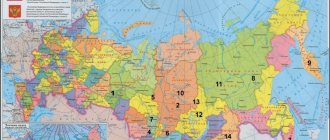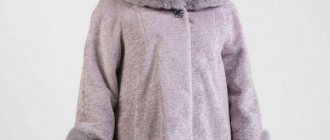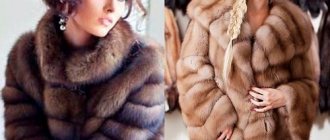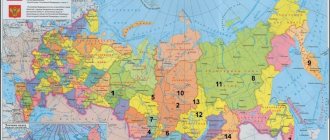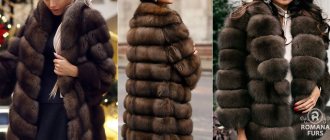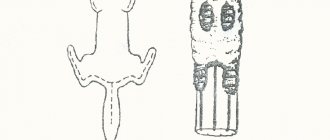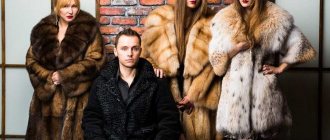Fur products for the residents of Yakutia are not a whim at all, but rather a necessity. But even in the most severe cold, the fair sex wants to remain beautiful. Sable fur, popularly called royal fur, is perfect for solving this problem. In order for a sable fur product to last a long time and at the same time look expensive and rich, it is important to know a few nuances. What you need to pay attention to when selecting furs and how to distinguish high-quality fur from defective fur, read in the material of the YakutiaMedia news agency.
Sable is always a sign of prosperity and luxury, so in order not to go wrong with the choice of raw materials for the same dream fur coat, corr. YakutiaMedia news agency turned to experts from the Sardaana Joint Stock Company of Arts and Crafts. The factory's products are known for their good quality and good quality, as experienced and qualified specialists work here, one of whom is design technologist Elena Tomskaya . She has been working at the Sardaana factory for 16 years and is well versed in all the intricacies of fur.
How much does sable skin cost (updated!)
Based on more precise figures, we obtain the following information: an interested buyer was offered two hundred nineteen thousand seven hundred and ninety-four skins.
Of these, two hundred thousand seven hundred and forty-five were Barguzin sable skins. The cost of a sable skin in its maximum form was two and a half thousand dollars. The average price of one skin varied about one hundred and sixty dollars.
Greek company Tsoukas Bros. & Sons purchased the most expensive lot, which in turn had the highest quality and, therefore, characteristics. The purchase was made specifically for the Italian fashion house Nijole. This house is famous for the exclusivity of its products, and, of course, quality. The prices for things produced there are appropriate.
Judging by the price of the skin that was paid at the auction and the place where the product was born, it is not difficult to guess that after some time a product made from it, be it a fur coat, a hat, or anything else, will decorate the wardrobe of the beautiful wife of one of the current top millionaires, who was lucky enough not to think about the question: “How much does a sable skin cost?”
The remaining sable skins, from other Russian regions, noticeably lagged in price from the Barguzin maximum. The closest matches turned out to be sable skins originally from Kamchatka. The maximum price they could come up with was three hundred and seventy dollars per unit. The organizer of the auction was the well-known company from St. Petersburg “Soyuzpushnina”. They reported that the cost of sable skins had increased by almost forty percent when comparing this auction with the auction in two thousand and ten. The organizing company also reported that such success at this auction was due to the high-quality and wide range of goods for every taste and pocket. In recent decades, this was the best trade imaginable.
In principle, Barguzin sable could never be called cheap, which is why it was considered expensive, but in a way that now prices for it have not yet risen - rapidly and quickly. This, of course, is not a surprising phenomenon, because the global fur market is developing quite actively, and the demand for products is growing every day. This fact also influenced the rise in prices for other types of sable, in addition to Barguzin. The answer to the question “How much does a sable skin cost today?” most likely will not console the buyer, because the sable of the Amur Ridge has become more expensive by about eighty percent, while the sable of the Yenisei Ridge has risen in price by ninety-five, which is approximately twice the previous price.
Despite this rise in price, which can easily be called quite sharp, the sable of the Barguzin Ridge continues to lead in popularity, and, of course, in price.
Sable fur
The sable is a valuable fur-bearing animal, very similar in appearance to the marten, with beautiful, lush and silky fur. It is distributed in forest-tundra and forest zones from the Ural Mountains to the Pacific Ocean.
Description
The size of the skins varies from 15 to 48 cm in length and from 12 to 30 cm in width, area - from 23 to 80 cm2. Fur color is highly subject to geographic and individual variability and ranges from almost black to light yellow. In the places where this animal and the marten live together, in the western part of the range, the differences between both species are minimal. In general, sable skin has thicker, softer and silkier fur. The main difference between one species and another is the shape of the throat patch - in sable it is round or oval and does not extend onto the chest. A complete list of differences is given in the article about the pine marten.
Color categories and ridges
Due to pronounced variability, it is customary to divide all skins into seven color categories, which in turn, for convenience when purchasing, are combined into four groups.
1
The first color (high head, normal head, high headrest) is the darkest fur from dark brown to black, the color of the down has a gray-blue or dark blue tint and is uniform along the entire length of the hair.
The second color (normal headband) is the general color - brown, the guard hairs are dark brown, the fluff is blue-gray at the base and chestnut at the top.
The third color (collar dark) - the hair is brown, medium dark, consists of a chestnut-colored spine and gray-blue fluff at the base and light chestnut at the tips.
2
The fourth color (normal collar, fur) - the general color is light, the guard hairs are light brown, the down is gray, sometimes with a bluish tint at the base and sandy at the tops. This group also includes all other light-colored skins.
Taking into account the clear geographical variability of the animal skins, they are divided into ten ridges. It is difficult to distinguish them from each other based on the commercial properties of the fur, so GOST specifies elements of the primary processing of sable skins that make it possible to more accurately determine one or another ridge.
Furs are grouped into four groups according to the method of removal and forms of dressing the skins.
First group
Kamchatka Ridge - the fur is thick, lush, with a high, rough awn. Yakut region - lush, silky, awn of medium height. Sakhalin region - the hair is thick, the awn is short and rough. Amur region - short, silky, with low spine. The skins of this group are removed with a stocking, the shape of the edit is round, the ratio of width to length is 1:2, the front and hind legs are tucked inside.
Second group
Barguzinsky district - the fur is thick, lush and silky. The skins should be removed with a tube, the shape of the edit should be rectangular, the ratio should be 1:2, the front legs should be tucked in, the hind legs should be tucked outside.
Third group
The Yenisei Ridge has lush, silky and rough hair, the spine is of medium height. Tobolsk region - the fur is lush, thick and rough. The skin is removed with a tube, the shape of the edit is semi-long, the ratio is 1:3, the front and hind legs are on the outside.
Fourth group
The Minusinsk Ridge has thick, silky hair and a short awn. Altai region - the fur is lush, thick, the spine is rough with slightly curled tops. Tuva region - less dense, silky, high awn. The skins are removed with a tube, the straightening shape is long, the ratio is 1:4.5, the front paws are tucked in, the hind paws are tucked in outside.
3. Editing forms
The sable molts twice a year. Winter fur has a uniform light color due to the large number of downy hairs. The color of the tail is the same as on the back, only slightly darker towards the tip. Summer cover is sparse, low and coarse, with virtually no down. The color is generally darker than winter.
4
Characteristics and evaluation of skins in different periods of the year
First grade (winter).
The fur on the skins is fully formed - tall, thick and shiny. The flesh is thin, there is no blueness.
First grade, medium defect (late winter).
The skins have slightly faded hair, and there is a slight thinning of the spine on the sides. There is no blue on the flesh.
Non-standard (spring, summer, autumn).
At the beginning of spring, the cover on the skins is still thick and high, but with obvious signs of overripeness: the spine is dull and thinning on the nape and sides. Leather fabric is clean. Around mid-spring, a period of active molting begins - the hair loses its elasticity, thins greatly over the entire area, tufts form in places, and new growth of hair is observed. The skin is blue and thickened. In summer, the fur is low, sparse, and there is very little fluff. The mezdra is light. With the arrival of autumn, new growth is actively growing; it is already quite dense, but still very low and only protrudes slightly above the down. The fabric is dark and thick. In mid-autumn, the animals have thick fur that is only half grown.
Second grade (early winter).
Thick, shiny and fairly tall fur. The mesra is slightly thickened and has a slight blue tint.
Primary processing
Skins from sables of different ridges are removed in accordance with the above GOST. The tube removal technology is similar to that of the marten; its description can be found here.
When shooting with stockings, the first cuts are made on the head - the skin of the lips and nasal cartilage are trimmed, then, wrapping the skin over the muzzle, the eyelids and ear cartilage are trimmed. After this, securing the carcass to the head, the skin is pulled off completely. No cuts are made on the paws; the claws remain on the skin. The skin at the anus is trimmed along the fur border. After the skin is completely removed, the tail is cut lengthwise along the lower surface.
After filming, the raw material is thoroughly fleshed and degreased.
Fresh-dry canning.
All sable skins are straightened with the fur facing out. Correction of skins removed with a stocking and a tube is carried out on the appropriate rules in accordance with the accepted requirements for each ridge
Unified established types of rules are not given in regulatory documents, so hunters use the following constructions.
Rules by Elkova A.A.
Designed for straightening skins removed with a tube and giving them a rectangular shape.
5
Designs by Ignatov Yu.V.
Also intended for straightening skins removed with a tube, they are used to give a long shape. They are divided into three numbers.
No. 1 Length - 65 cm, width at the base - 10.9 cm. No. 2 Length - 60 cm, width - 10 cm No. 3 Length - 55 cm, width - 9.2 cm
The width of the planks is 2-2.5 cm, thickness - 1 cm.
6
Rules for oval design
Designed for straightening skins removed with stockings and giving them a rounded shape. They are manufactured in three numbers.
7
No. 1 Length - 48 cm, width - 12 cm. No. 2 Length - 40 cm, width - 10 cm. No. 3 Length - 32 cm, width - 8 cm.
Fur quality assessment
Sables are caught in two of the most effective ways: shooting with a gun and various self-catching methods. With both extraction options, defects occur in furs. When shooting with guns, there are traces of lumbago, hair damage from shot or bullet, fur stained with blood, as well as lacerations from a hunting dog. When fishing by self-catching, the following defects occur: the absence or damage of a paw and damage to the fur by forest inhabitants.
A considerable number of skins also have defects resulting from improper shooting and initial processing. Taking into account the high price of animal fur, hunters must be very careful in all stages of processing. Avoid incorrect cuts, ruptures, drafts and other defects.
The price for sable is one of the highest in the wild fur industry; the cost varies across the country, for example in the 2011/12 season. (Kirov) she was accepted in the area for only 2500 rubles.
Choosing skins
According to the expert, sable fur varies in color and grey. The darker and grayer the fur, the more luxurious, richer and, accordingly, more expensive the fur: “Sable has four colors - dark, dark-light, light and very light. In Yakutia, dark and gray sables are found in the Olekminsky and Aldan regions, in the north there are light-colored sables. It is interesting that dark sable is always smaller in size and has thinner hair than light sable. The light color is always fluffy and the size of the sable is larger.”
Royal fur: how to choose the right sable skins. Photo: Michiel Yakovlev
Royal fur: how to choose the right sable skins. Photo: Michiel Yakovlev
Royal fur: how to choose the right sable skins. Photo: Michiel Yakovlev
Royal fur: how to choose the right sable skins. Photo: Michiel Yakovlev
1
/ 4
You can purchase the coveted soft gold from hunters and fishermen, or from private individuals, as well as at auction. “It can be very difficult to select skins from hunters and trappers, since there is a high possibility of losing raw materials. It seems that the skins are not bad, medium in color, fluffy and large, but after dressing they can come with a high percentage of defects. Therefore, it is more profitable to purchase skins selected at auction according to color and size. All this is done by professionals there. In February of this year, the Sardaana factory purchased sable skins at an auction in St. Petersburg of excellent quality and will now purchase them there every year,” said Elena.
It is worth noting that wild sable skins can be different. Therefore, defects are common, even in auction lots. No one is immune from this.
When selecting a skin, the first thing you need to pay attention to is the hairline. The skin of a mature sable should be shiny and silky. You need to feel the hair and comb it in different directions. If there is a bald spot, it is immediately visible. The quality of the cover depends on the dressing. With strong furring, you can damage the hair follicle, which will cause the fur to shed.
Then you need to turn the skin out and pay attention to the inside. It must be undamaged. If the animal was shot, then the flesh will be in holes, and the wool will be in small splits. This is already a marriage.
If the skin is fresh, the flesh should be white and elastic. Old flesh looks different - with scuffs and stains.
Royal fur: how to choose the right sable skins. Photo: Michiel Yakovlev
As mentioned above, sable with gray hair is one of the most luxurious types of fur. “A perfect set of gray and dark sable is very rare. At auction, the darkest and highest quality sable is called the top lot. One such skin costs approximately 50 thousand rubles. We take medium dark, as close as possible to it,” the expert added.
As Elena Tomskaya noted, tinted sable fur is neither good nor bad: “We mainly work with natural fur. For some reason, people have a stereotype that if the fur is dyed, then it must be old. But that's not true. For example, we buy skins from a fisherman. He brought 300 skins, so we take these 300, even though they are not twins and not included in one lot. There are no 300 twin skins; they need to be matched to each other. Therefore, there is such a practice when you have to even out the color. This does not mean that the fur is dyed, no.”
The specifically painted sable is immediately visible. Their shine is different and their hair looks different.
There are also skins that are absolutely identical in color and size, but in structure one is shiny, the other is matte. You can’t put them side by side, so you need to pay attention to this too.
In addition, you need to look for the presence of cracks, so-called creases. “There are creases in almost all types. They write on the Internet that creases appear from pollution, and when the down gets dusty, it splits. But according to my observations, creases appear even on clean fur. Therefore, I believe that it depends on the diet and habitat of the animal. The sable is wild, we don’t know how he lived there,” the expert believes.
A lot depends on the time of year. Sable ripens in the harshest frosts. In the most severe frosts, their fluff fluffs up, and then it ripens. Imported fur is simply airy, while Yakut fur is valued because it is fluffy and fluffy.
“There is also a caged sable, which is bred through selective breeding. It has the perfect dark color - just the dream of all Yakut women. There are no complaints about its color, but its quality is already different. His hair is long, his fur is not fluffed, his down is completely thin. Firstly, it is grown in central Russia, and secondly, its food and living conditions are completely different from wild ones,” the expert explained.
An important point is the smell. The skins should not give off an “animal” smell. “We have people who have been saving skins for three years at home, and the smell of fat already appears on these people. Untreated fur produces its own fats and this fat begins to corrode the skin tissue, the inner skin becomes weaker, so the skins begin to tear. Therefore, it is better not to delay sewing the product, or to store furs in fur refrigerators. As for the finished product, it must be emphasized that an old fur coat smells terrible. The product itself ages and absorbs perfume, such a mixture gives off terrible aromas.”
The value of sable fur
Since ancient times, sable has been the most valuable fur-bearing animal in Russia. A sable fur coat, or at least a hat, was (and is still considered) an indicator of a person’s high status in society. Sable furs formed the basis of Russian exports for centuries. To this day, sable is the “king of fur.” Few furs can compete in value with sable. Guess which fur is the most expensive in the world?
Why is sable fur so valuable?
The most important indicator is the durability of fur. Sable fur is unique - about 95%. That is, even after 10 years, if it is not deliberately damaged, the fur product will look almost like new. For example, the durability of lynx fur is 90%, American mink up to 75%, European mink on average 55%, rabbit and chinchilla 15-20%.
But besides wearability, beauty is also important. High quality sable fur has a simply gorgeous look. It has a “shimmer”, light, warm, silky to the touch, with noble silvery gray hair. Color variations are different. By the way, it is not yet possible to raise sable with high-quality fur in captivity. The only sable farm that has achieved unique results is on the verge of closure. The best fur is harvested from November to December. Moreover, the quality of the fur does not depend on the age of the animal. The only thing is that older individuals have more silver hair.
Not only are sables not bred in captivity, but they are also extremely difficult to hunt. These are quite secretive small predators that live in hard-to-reach, sparsely populated areas with a harsh climate. The habitat is extensive, but most of it is Russia (95% of the population). The remaining 5% settle in the northern regions of Korea, Mongolia, China and Eastern Kazakhstan. Perhaps the highest density of sables is found east of the Siberian Yenisei River. The most expensive are the skins of Barguzin sables, which live in a special microclimate. They have the thinnest, and therefore light and soft skin, the fur is especially shiny, has a rare dark color and a lot of silver (gray) hair. If the average cost of a skin is $100-200, then for Barguzinsky you can get $3,000.
Not every hunter has the legal right to hunt sable. You need to purchase an expensive license. Each fisher is assigned a quota for the territory. They go fishing at the end of October, because sables grow their best fur in November-December. Only in the New Year do they return from fishing, having spent two months on a difficult trek through deep snow, far from medical care, in extreme temperatures of -50°C. The average production of sable skins is 150-300 pieces per hunter. Such a small number of skins is explained not by the small number of animals, but by their way of life. Each male stakes out a fairly large territory and does not allow other males to approach. Due to the low density of sables, the hunter has to cover large areas. Sables are caught only in traps. All day long, hunters within their quota walk around the territory in a circle, setting and checking traps. At the end of the hunting season, hunters hand over trophies to certified hunters.
Fur gradation
Why aren't sables caught in the summer? Because the fur is of poor quality. The underfur is poorly developed, the hair is coarse, short, less dense. The color during this period is uniformly dark brown. You won’t seduce fashionistas with such fur.
But with the onset of autumn cold weather, the fur grows quickly and becomes thicker. The underfur becomes dense (24-28 mm), retaining heat perfectly. There is even a bluish color. The pile itself acquires shine and noble gray hair, reaching 48 mm in length. The color of different representatives becomes unique: from black to sand. The value of fur depends significantly on color. Sables of dark colors are valued higher than light-colored ones. According to this parameter, fur is classified into 4 categories and 8 colors. The first category includes the darkest skins, the 4th category the lightest.
- The 1st color is the rarest - pitch black. Only a few occur in nature.
- The 2nd color is very dark, similar to the mahogany color of minks. In the best seasons, 10,000 skins are harvested. This is very little, because it takes 55-65 skins to make a fur coat. All over the world, about 100 fur coats of the second color are sewn per year.
- The 3rd color is also rare - a little lighter than the second. Fur products made from it are very expensive, but are already available to the average person. About 100,000 skins are harvested and about 1,000 fur coats are sewn.
- The 4th-7th colors are lighter in increasing order.
- The 8th color is sand, the most accessible. Perhaps this color is not the “coolest”, but the quality of the fur does not really depend on the color. Light fur coats, hats, and mittens are also very warm, pleasant to wear, and durable.
Russia has developed its own classification of sable fur into seven colors. The darkest ones are called “high head” and “normal head”. Next, the “headrest” is high and normal. Down in terms of prestige are “dark gate”, “normal gate”. The seventh category is the lightest - “fur”, at a cost five times cheaper than “heads”.
With the transition of sable fur into mass culture (fashion), the attitude towards classification has changed somewhat. In particular, they began to pay less attention to colors, but more to the size of the skins. As a result, the larger pelts of males are 40 percent more expensive than the fur of females.
In addition to the color scheme, the division is made into ridges - habitats of subspecies. Depending on the microclimate of the habitat, a slightly different structure of the skins is noted. Sables of the Barguzin Ridge live in Transbaikalia. Their fur is the most valuable. Kamchatka and Yakut sables are considered to be of excellent quality. The fur of sables from warmer regions is slightly coarser and less fluffy: Yenisei, Altai, Tobolsk, Amur, Minusinsk, Sakhalin, Tuvan sables.
Issue price
The cost of skins depends on the quality of fur, thickness, silkiness, color, gray hair, size, conditions, etc. The determining factor in the modern market: the fluffiness and silkiness of the fur. According to these parameters, the leaders are Barguzin sables of all sizes, medium and small Kamchatka sables, and well-furred Yenisei sables. Blue furs are highly prized. The market value of skins from all ridges is $50-1500.
- The cheapest skins are from Sakhalin sables. They are small and have rough pile.
- Kamchatka are the largest. But the larger the specimen, the coarser the fur.
- The darkest skins are from the Yakut ridge. Their fur is very delicate, but short.
- Minusinsk and Kamchatka sables have the most gray hair.
- Because of their light fur, Yenisei sables are often painted in biscuit, blue, and dark tones.
- The most expensive are elite specimens of Barguzin sables with impeccable fur, very dark color, with a lot of gray (silver) hair. The cost of individual unique skins reaches $9,000. Prices of $3,000 are no longer uncommon.
- The cost of a fur coat made from elite fur of the same type in color, structure and gray hair reaches up to $100,000. Sometimes the skins for one fur coat take several years to select.
